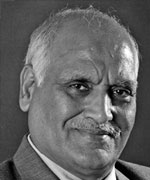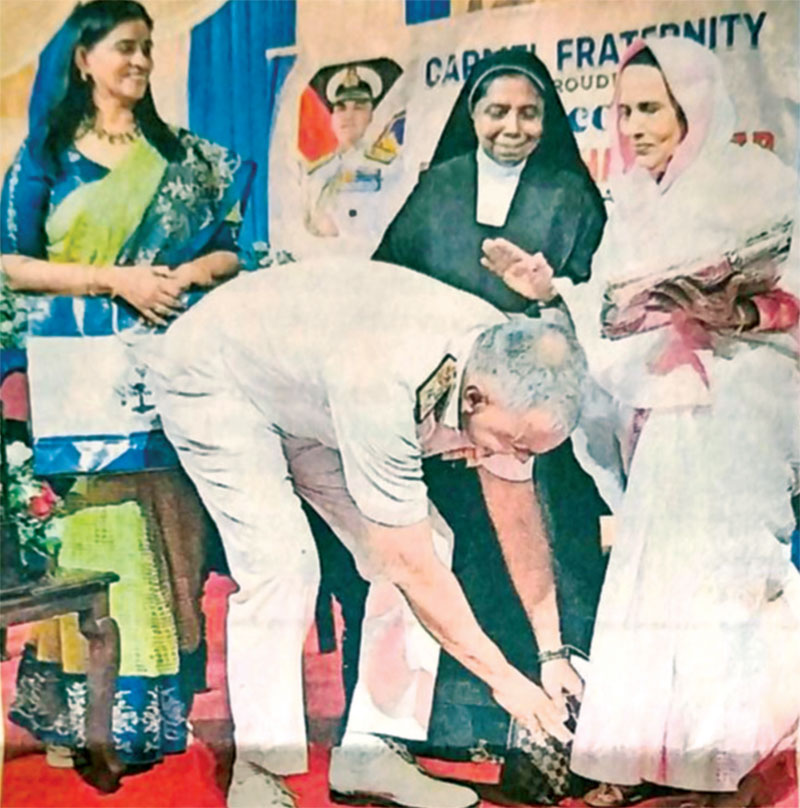Being secular and apolitical is critical to the professionalism of our forces
 Maj. Gen. Raj Mehta (retd)
Maj. Gen. Raj Mehta (retd)
On 14 January 2024, Western Army Commander Lt Gen. Manoj Kumar Katiyar who took over on 1 July 2023, spoke briefly at the Command Investiture ceremony about the ethos of the Army. “What makes the Indian Army stand out is that we strictly adhere to two important principles: our secular approach and our apolitical character,” he said. “It means we respect all religions and steer clear of politics. It is necessary to stick to apolitical and secular principles and recognise the fact that any compromise or lack of adherence on these fronts will be harmful for the Army.”
On 28 February 2024, Naval Chief Admiral R Hari Kumar won a billion plus hearts across India when he visited his alma mater Carmel Convent Higher Secondary School in Vazhuthacaud, Trivandrum. Watched by his proud wife and emotional school Director Sister Revita, the Admiral, in full dress uniform, touched his former teacher, a Muslim, Ms Jameela Beevi’s feet, recalling how she’d helped him clear the Malayalam language test to qualify for admission.
These examples of right secular conduct by apex military officers in the best traditions of the armed forces have warmed the cockles of serving/retired personnel’s hearts. This has made the recent controversy involving the leaking of sensitive excerpts from ex-army chief Gen. M.M. Naravane’s forthcoming book Four Stars of Destiny seem a small blip that caused momentary rancour.
Though Indian military history goes back to the Bronze Age (3300 to 1300 BCE), this article focuses on the contemporary Indian Army as it evolved starting from British rule in the mid-eighteenth century. The innocuous trade beginnings quickly converting to the raising of the Presidency Armies will be briefly discussed as also their merger into the British Indian Army, and it’s partitioning following the grant of Independence to India and Pakistan in August 1947. The focus will be on the legacy of the current Indian Army and how it is poised to execute its charter as a world benchmarked military force.
However, before proceeding further, an important ancient military referral is worth flagging. Romila Thapar in her History of Early India writes that the Nanda dynasty never had a chance to use their humungous Indo-Gangetic army of infantry, horse cavalry and war elephants against the Greeks as Alexander invaded India in 327 BC. Following his conquest of Persia, Alexander in two years crossed Punjab’s five rivers after his success on the Hydaspes (Jhelum), stopping on the Hyphasis (Beas) where his army mutinied fearing a losing clash with the Nandas. The battles, including the climacteric one against Porus, were hard-fought. Alexander was seriously wounded while retreating, leaving governors behind to manage his conquests. Young Emperor Chandragupta Maurya in 321 BC defeated the Nandas, bringing in for the first time, imperial ambitions and systems and a warfighting treatise, Arthashastra.

British Traders and Conquerors
Christopher Gibbert in The Great Mutiny writes that the royal charter granted in 1600 in England to the East India Company (EIC) and Merchants of London for trade with the East Indies was encashed by the British Ambassador in Mughal Emperor Jahangir’s court in 1613 to establish a permanent trading station in Surat. The EIC directors were advised by their ambassadors at the Mughal court not to seek “plantation by the sword” like their predecessors, the Portuguese and the Dutch. In 1707 however, Aurangzeb died and thinly camouflaged opportunists the EIC harvested the chaos that followed to become a military and mercantile power. With France and England at war in Europe, war broke out between them in India too.
A scratch army raised by the company and commanded by Robert Clive, a former clerk in its Madras office, defeated the French and their Indian protégé at Plassey in 1757, making the British masters of Bengal. In 1773, Parliament appointed Warren Hastings as Governor General in Bengal with supervisory authority over the Bombay and Madras Presidencies. In 1784, a Crown Minister was appointed president of the board of control to oversee EIC officials. EIC over time became the agent of the British government in India. It also became responsible for the three Presidency Armies manned by sepoys and sowars. Native officers came in but the senior most was subordinate to the junior most British officer and couldn’t order even a British Sergeant Major!
Presidency Armies
In his iconic book, A Matter of Honour: An account of the Indian Army, its Officers and Men, Philip Mason writes that the French were quicker to perceive that Indians might be trained and disciplined as soldiers just like Europeans and experimented with such a force as early as 1674, leading them successfully against a strong Dutch force attacking French-held Pondicherry in 1693. In 1739, the French armed 4,000-5,000 Muslim natives trained and drilled after the European model. “Thus was conceived” wrote Fortescue “the embryo of a Sepoy Army”. In 1746, M Paradis, a French engineer officer with 230 French soldiers and 700 sepoys with no artillery defeated a ten times larger native force at San Thome. The British until February 1747, used Indian natives just as peons, arming some without training, disciplining or placing under direct British command.
The origin of the British Indian Army lies in the origins of the Presidency Armies of the EIC which preceded it. The first purely Indian troops employed by the British were watchmen employed in each of the Presidencies of the EIC to protect their expanding trading stations. These natives were all placed in 1748 under one Commander-in-Chief, Major General Stringer Lawrence, regarded as the "Father of the Indian Army" and its first Chief.
In 1757, Robert Clive came up with the idea of sepoy battalions for the Bengal Presidency - trained, armed and dressed like the red coats (British soldiers) commanded by a nucleus of British officers. The Madras Presidency followed suit in 1759, followed by the Bombay Presidency in 1767. Recruitment in all cases was done locally, with battalions drawn from specific communities, villages, and families. Regular cavalry regiments were raised in 1784. Irregular cavalry were raised and employed by rulers of Indian states, these having very few British officers. In addition, native artillery and pioneers (referred to later as Sappers and Miners) were also raised.
The Bengal Army, Madras Army and Bombay Army were quite distinct, each with its own regiments and a cadre of European officers. All three armies contained European regiments in which both the officers and men were Europeans, as well as a larger number of ‘"native” regiments, in which the officers were Europeans and the other ranks were Indians. From the mid-eighteenth century onwards, the Crown began to dispatch regiments of the regular British Army to India, to reinforce the Company's armies. These troops are often referred to as “H.M.’s Regiments” or “Royal Regiments”. In 1844, the combined average strength of the three armies was 2,35,446 native and 14,584 European. A single battalion regimental system was in vogue in the Presidencies with regiments numbered as per their seniority of date of raising.
Initially, only Europeans served as commissioned or non-commissioned officers. In time, Indian Army units were garrisoned from Peshawar in the north, to Sind in the west, and to Rangoon in the east. The army was engaged in the wars to extend British control in India (the Mysore, Maratha and Sikh wars) and beyond (the Burma, Afghan, First and Second Opium Wars and the Expedition to Abyssinia). The Presidency Armies, like the Presidencies, belonged to EIC until the 1857 mutiny when the Crown took over all EIC assets/armies. European regiments were amalgamated in 1860 with the British Army, but not its “native” regiments. The three Presidency Armies therefore continued to exist. Post the mutiny, recruitment of ‘“native” regiments switched to the “Martial Race” system. Another change resulting from the mutiny of 1857 was that henceforward artillery was confined to the British Army. In 1895, the Presidency Armies were abolished, a unified Indian Army coming into being.
In 1895, the Indian Army began its formal existence and was the “Army of the Government of India”, including British and Indian (sepoy) units till 1902. In 1903, Lord Kitchener became the Commander-in-Chief of the Indian Army and instituted large-scale reforms. He formed higher level formations, eight army divisions, and brigaded Indian and British units. Following Kitchener’s reforms, terminology used for military forces in India was altered, with the Indian Army being “the force recruited locally and permanently based in India, together with its expatriate British officers.” The British Army in India referred to British Army units posted to India for a tour of duty from the United Kingdom. The Army of India meant the combined forces of the Indian Army and British Army in India.
Commissioned officers, British and Indian, held identical ranks to commissioned officers of the British Army. Viceroy's Commissioned Officers were Indians holding officer ranks. They were treated in almost all respects as commissioned officers, but had authority over Indian troops only, and were subordinate to all British King's (and Queen's) Commissioned Officers and KCIOs. They included Subedar Major or Risaldar-Major (Cavalry). Recruitment was entirely voluntary; about 1.75 million men served in World War I, many on the Western Front and 2.5 million in World War II. Non-Comissioned Officerss included Company Havildar Majors equivalents to a Company Sergeant Major; Company Quartermaster Havildars, equivalents to a Company Quartermaster Sergeant; Havildars or Daffadars (Cavalry). equivalents to a Sergeant; Naik or Lance-Daffadar (Cavalry), equivalents to a British Corporal; and Lance-Naik/Acting Lance-Daffadar (Cavalry), equivalents to a Lance-Corporal.
You must be logged in to view this content.

